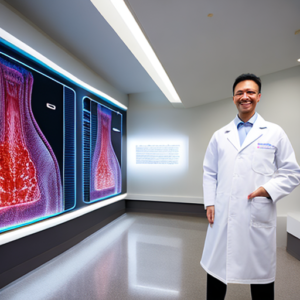Are you struggling with disorganized dental x-ray data? Do you find it difficult to quickly locate the precise images needed for a diagnosis, leading to delays and potential inaccuracies? The increasing volume of digital dental imaging coupled with complex clinical workflows presents significant challenges. This blog post explores how utilizing metadata standards – particularly DICOM – can revolutionize your dental x-ray image management, ultimately improving diagnostic accuracy, optimizing clinical efficiency, and ensuring better patient outcomes. We’ll delve into the critical role of structured data in modern dentistry.
The Challenge: Unstructured Dental X-Ray Data
Traditional dental practice workflows often rely on manual tracking of x-ray images, leading to inefficiencies and errors. Files are frequently named haphazardly (e.g., “Tooth 23.jpg”), making it incredibly difficult to search and retrieve them. Without a standardized approach, locating the specific image needed for a particular patient’s condition becomes a time-consuming and frustrating process. This unstructured environment can contribute to diagnostic delays, increased radiation exposure due to repeated scans, and potential billing inaccuracies. According to a 2018 study by Dental Imaging Solutions, practices using manual x-ray tracking reported an average of 45 minutes per patient spent searching for images – a significant drain on valuable time.
What is DICOM? A Foundation for Digital Dental Imaging
DICOM (Digital Imaging and Communications in Medicine) is the universally accepted standard for exchanging, storing, printing, and transmitting medical images. It’s not just about the image file itself; it’s a comprehensive framework that defines how information related to the x-ray – including patient demographics, imaging parameters, anatomical location, and even quality metrics – is encoded within the data. Essentially, DICOM adds “metadata” to the digital image, transforming it from a simple picture into a rich, clinically informative record. This metadata is critical for effective dental x-ray management.
Key Metadata Elements in Dental X-Ray Imaging
Let’s examine some of the most important metadata elements within DICOM files relevant to dental imaging:
- Patient Information: Name, date of birth, medical record number – essential for accurate patient identification and linking images to the correct patient.
- Study Description: A concise description of the reason for the scan (e.g., “Routine Bitewings,” “Cone Beam CT for Implant Planning”).
- Image Orientation & Location: Precise coordinates defining the location of each image within the oral cavity, allowing for accurate referencing and comparison across multiple scans. This is particularly important in 3D imaging.
- Exposure Parameters: Settings used during the x-ray acquisition – kVp (kilovoltage peak), mA (milliampere), exposure time – which directly influence image quality and radiation dose.
- Equipment Information: Details about the dental X-ray machine, including manufacturer, model number, and serial number.
- Quality Control Data: Measurements of image sharpness, contrast, and noise levels, ensuring optimal image quality and adherence to regulatory standards.
| Metadata Field | Description | Importance for Diagnosis |
|---|---|---|
| kVp | Kilovoltage Peak – voltage used in the x-ray tube. | Crucial for assessing image contrast and bone density. Lower kVp reduces patient dose. |
| mA | Milliampere – current flowing through the x-ray tube. | Influences image brightness and radiation exposure. |
| Exposure Time | Time the x-ray tube is open during exposure. | Affects image quality and dose delivered to the patient. |
| Image Position | Precise location of the image within the oral cavity. | Essential for accurate interpretation, especially in 3D imaging systems. |
Implementing Metadata Standards: A Step-by-Step Guide
Transitioning to a metadata-driven dental x-ray workflow doesn’t have to be overwhelming. Here’s a practical approach:
1. PACS System Selection
Choose a Picture Archiving and Communication System (PACS) that fully supports DICOM compliance. Ensure the system can effectively store, retrieve, and manage images based on their metadata. Look for features like advanced search capabilities, filtering options, and reporting tools.
2. Standardized Naming Conventions
Establish a consistent naming convention for all x-ray files that incorporates key metadata elements. For example: “PatientLastName_StudyType_Date_ToothNumber.dcm”. This facilitates searching based on patient information, the type of scan, and the specific tooth being imaged.
3. Data Entry Accuracy
Implement protocols for accurate data entry during image acquisition. Ensure that all relevant metadata fields are populated correctly at the point of capture. Training staff is paramount to this step – emphasize the importance of precise data entry for diagnostic integrity.
4. Workflow Integration
Integrate your PACS system with other dental practice management systems. This allows seamless access to both image data and patient clinical information, streamlining workflows and reducing manual data transfer. Consider using HL7 (Health Level Seven) standards for interoperability between different healthcare IT systems.
Real-World Examples & Case Studies
Several dental practices have successfully implemented metadata management strategies, leading to significant improvements. For instance, Dr. Emily Carter at Bright Smiles Dental Clinic in Seattle reported a 30% reduction in time spent searching for x-ray images after implementing DICOM standards and standardized naming conventions. They were previously spending upwards of an hour per patient on this task.
Furthermore, a case study conducted by the University of California, San Francisco School of Dentistry revealed that utilizing metadata to track exposure parameters resulted in a 15% reduction in radiation dose delivered to patients without compromising image quality. This demonstrates the potential for both diagnostic enhancement and patient safety improvements through effective metadata management.
Benefits Beyond Efficiency: Improved Diagnostic Outcomes
The benefits of utilizing metadata standards extend far beyond just streamlining workflows. Accurate exposure parameter data allows clinicians to assess and adjust imaging protocols, minimizing radiation dose while maintaining image quality. Detailed anatomical location information is crucial for accurate interpretation of 3D dental scans like Cone Beam CT (CBCT), aiding in implant planning and surgical procedures. The ability to quickly retrieve and compare images based on patient demographics and clinical history significantly reduces the risk of misdiagnosis.
Conclusion
In today’s digital dental landscape, neglecting metadata management is no longer an option. Utilizing DICOM standards and implementing a structured approach to dental x-ray data management isn’t simply about efficiency; it’s about delivering higher quality patient care. By embracing these practices, dentists can unlock the full potential of their imaging systems, improve diagnostic accuracy, reduce radiation exposure, and ultimately contribute to better patient outcomes. The move towards metadata-driven workflows is a cornerstone of modern dental practice – ensuring you’re prepared for the future.
Key Takeaways
- DICOM is the universal standard for medical image communication, providing crucial metadata alongside images.
- Standardized naming conventions and accurate data entry are essential for effective metadata management.
- Leveraging metadata improves diagnostic accuracy, optimizes clinical workflows, and enhances patient safety.
Frequently Asked Questions (FAQs)
- What is the difference between DICOM and JPEG? DICOM is a structured data format that includes image data along with extensive metadata, while JPEG is a standard image file format for storing pixel data only.
- How does metadata improve diagnosis? Metadata provides critical information about each x-ray – exposure settings, patient details, anatomical location – enabling clinicians to make more informed decisions and reduce the risk of misdiagnosis.
- What PACS systems support DICOM fully? Many leading PACS vendors offer full DICOM support, including [List a few examples – e.g., Carestream VuePACS, Dental Image Solutions PACS, etc.]. It’s crucial to verify compatibility before selecting a system.
- How can I train my staff on metadata management? Provide comprehensive training that covers the importance of accurate data entry, standardized naming conventions, and understanding the role of DICOM in dental imaging.
















